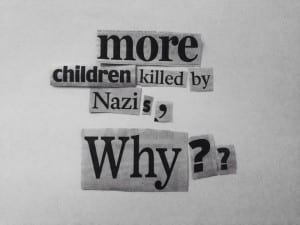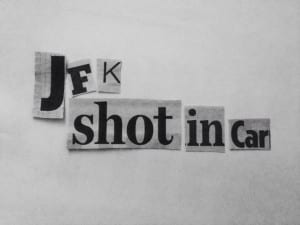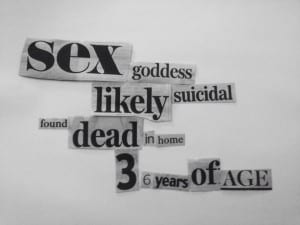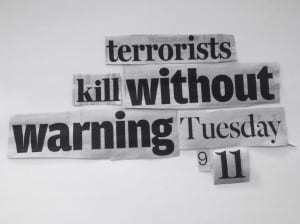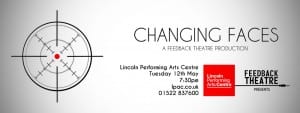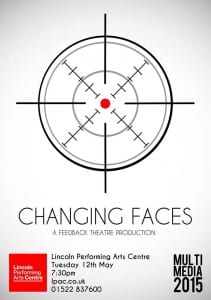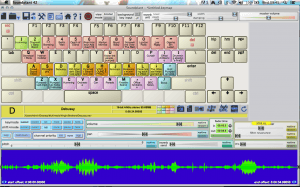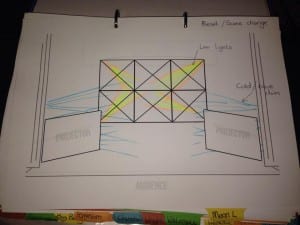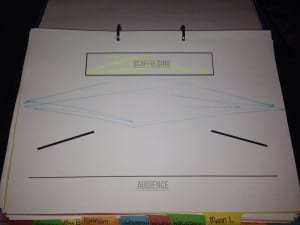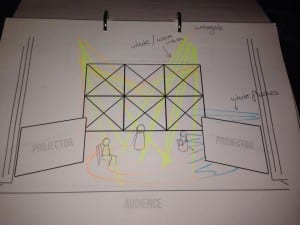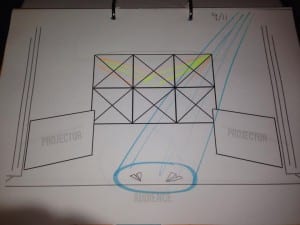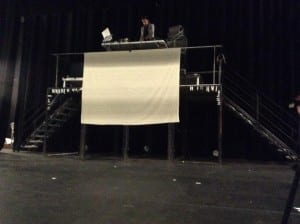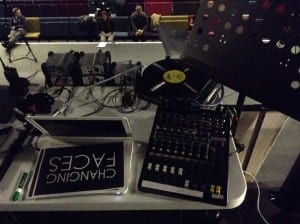EXPERIMENTATION.
Give me a camera and a projector and honestly I’m like a kid at Christmas. I can get very easily excited over multimedia theatre, it’s something I’ve taken interest in since I started taking drama seriously, so being able to just have some time to ‘create’ is something I treasure.
This week we were allowed to do just this. As a group we were given two cameras and two projectors and let loose to see what we could do with live feeds. Steve Dixon wrote, “for many performance artists” including us, “Digital technologies remain tools of enhancement and experimentation.” (Dixon, 2007, 8) Experimentation is what we were aiming for, and that is what we did.
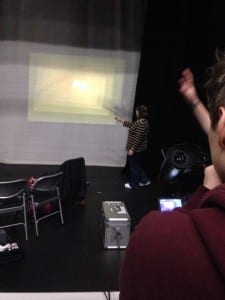
Here we looked at what happens if the live feed camera faces the projection. It created some kind of portal of light and images, which was fascinating and slightly trippy.
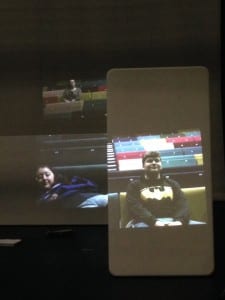
With clever set and projection placement, you can create a 3-dimensional image, or projection-mapping scenario.
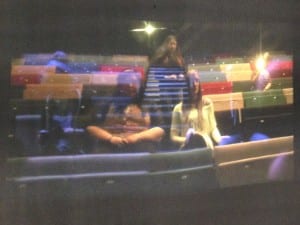
Finding two similar areas to film, and then placing the projectors to match the images, a ghostly effect can be created in the projected image.
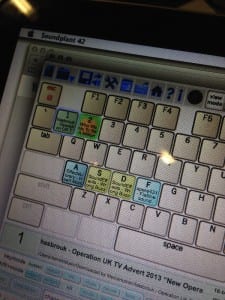


By hooking a makey-makey board up to soundplant then to a live body, we can create an interactive display. We chose to replicate the operation game board.
IDEAS ARE FLOWING.
We were asked to each come up with our own dystopian future, and mine took on this G.O.D idea and I explored it further here.
I also spent the time to script two scenes for this idea. One can be found here, and the other can be found here.
I took the time to begin to learn how to use after effects to create professional looking videos and I began to use these skills in creating motion logos for this idea.
Created entirely from scratch in after effects, I created this corporate motion logo for the G.O.D. The circles represented the eye, the typing was the importance of documentation, and the fact the screen gets swallowed by the eye shows how overpowering the G.O.D is.
Combining the previous video with the effect of twitch, I created a glitchy effect, like some rebel alliance is hacking the airwaves of the G.O.D
When this idea began to disappear, I quickly came up with an idea for a two-person version of this show, which can be explored here.
A LATE NIGHT SPARK.
Imagine a show where we see past the images we’re so used to. Where we can see into Marilyn’s dressing room, or to the men that made Martin Luther King. We can ask odd questions like ‘What does 9/11 sound like?’ and ‘What did the moon landing look like made out of television pixels?’
The possibilities are endless, and we can show so much with technology, from recreation, addition, focus on some tiny detail.
Stuff like that will make an interesting show – and entertaining when audience learn what is being shown.
I think it does exactly what we were asked to do. Show something that can only be shown with technology.
By chopping the newspapers of today, we can create the headlines of the past.
EYE FOR AN EYE. LENS FOR A LENS.
The camera. A piece of technology that is so inherent to the modern way we live our lives day after day. Every person who owns a mobile phone has a camera attached to his or her body at all times of the day. So where is it’s place in theatre? “Theatre is not virtual, it is real. It is exactly this quality that cannot be replaced by any other medium.” (Freiburg, 2010, 79) Which is all well and true but that doesn’t stop it combining with media to create something new. Why can’t theatre become more cinematic?
During this module and during the show we have to adopt a language that is not inherent to theatre, but instead theatre. Close-up, wide angle, post-production and so on… The function of the camera is to pick a part of an image and present it on a screen. Combine with theatre and “the material body and its subjectivity are extended, challenged and reconfigured through technology.” (Causey, 2009, 16) You can see things you otherwise wouldn’t see. A subtle hand move, the shaking of someone’s nerves, a quick eye dash. This was important when creating our show; we wanted to present things in new ways so why not close-up on the moments of history to show the subtle sides of it. We can see the queens nerves before she gets crowned, and we can see the subtle workings of a murderer.
MY DABBLE IN MARKETING.
I had a chance – though was rejected in the end – to work with marketing to create a look for the show. A full explanation of the things I achieved can be found here, but I present to you now the marketing elements I brought for the show.
Poster. Simple, effective.
Video trailers, that were circulated on social media before the show.
EVERYBODY KNOWS THE MUSIC FROM STAR WARS.
Music has the ability to make someone smile, cry, laugh or feel every emotion under the sun. It can take a simple movement to a fully orchestrated artwork. It is a vital part of cinema and TV, and when implemented to theatre can act as an emotional underscore to set a mood for the whole production.
When it comes to this production, a lot of what was wanted was asked for by the directors, which I always followed and achieved exactly what they envisioned but I did have a little bit of creative freedom when it came to how certain things sounded.
When designing the sound and music, it was incredibly important for me to remember, “Sound tells an audience what they cannot see. What is invisible to the audience, but near enough to be heard, becomes the domain of the sound designer… The sound we heard lied to us but still managed to create its own perfectly plausible reality.” (Collins, 2011, 29) This was not only applicable to sound effects like crowd sounds, to make it clear to an audience that there is a crowd just out of eyesight in the given scene, or a clock tick to fill the empty monotonous space, but it also applies to that of music that can create a mood or tension that an audience cannot otherwise pick up on. A monologue said to no sound would sound however the actor portrayed it, may that be angry, happy, sad, but with a low hum underneath, for example, adds a tension or uneasiness that an audience would have otherwise been missed out on.
JACK TULLIN. HISTORICAL DJ.
It is incredibly rare “for any designer to spend this much time in rehearsal with actors.” (Collins, 2011, 23) Given that in this module I chose to make sure I was at every rehearsal, regardless of whether I was called in or not, I was able to get a real feel for what the performance called for, and I was able to bring sound in from an early stage. In a production of Titus Andronicus, sound designer Collins took a similar approach. In his writing he talks of being able to understand the performance the entire way through the process, much like I did, and he talks about an “opportunity in this to perform – albeit from just off-stage… I had found that I could make my relatively crude playback devices work in perfect sync with their performances.” (Collins, 2011, 23) This was something I found I was able to do too, and was able to match sounds to the performances that took place, like making sound change slightly when people entered or left the room.
I chose to use a program called ‘Sound plant’ which we explored use with earlier in the module. The program allowed me to load sounds in, and play them along with a click of a button of my keyboard. I was able to loop, overlay and match the sounds to the exact second that needed to occur. This was helpful in every rehearsal and the plan is to use it in the performance live too with the audience being able to see what I’m doing at all times on a TV screen connected to my laptop.
A screenshot of soundplant, with my sounds loaded in.
I started to refer to myself as a historical DJ. Taking moments of history or using other sounds to reconstruct or add to moments from time. “The DJ activates the history of music by copying and pasting together loops of sound, placing recorded products in relation with each other.” (Bourriaud, 2002, 18) Whether or not it actual music or sound effects, I managed to play sound files and edit them live, along with layering to create the exact sound that needed to happen. I was able to fade in and fade out tracks live along with the action, add reverb or low pass filter when needed and overall create a live and interactive feeling to the sound.
UNEXPECTED INSPIRATION
During March of 2012 my college took me to see a performance of Romeo and Juliet at the Nottingham playhouse. They chose such beautiful artistic moments and presented the story in such an interesting way it has stuck with me. Their whole premise was the idea that everything that happened to Romeo and Juliet could have been avoided various times in the story. Each time something like this happened they played through the alternative, and then stopped – the lights blinded the audience, ticking played through the speakers, and then they repeated the same section with the original text. They used a calm humming sound at times to orchestrate the story, along with modern songs and high levels of multimedia. The show inspired me so much I found that I used a couple of the same techniques and feelings in Changing Faces with the sound and lighting.

The poster. Monochrome image with the bold red influenced my own poster design.
The Trailer. The low humming noise with fast ticking and flicking imagery has been a huge influence on my artistic style and these elements have found their place in Changing Faces.

Image of Juliet in front of lit up platform.
ANOTHER OPENING ANOTHER SHOW
Bang. Hum. Scene.
Bang. Hum. Scene.
Bang. Hum. Scene.
“Music and effects can have similar attributes. You may be involved with a production where you find that music would be completely inappropriate. For whatever reason, adding even the most minimal of melodic themes to this production would make a dramatic moment melodramatic… remember that you can use sound effects to create a moment just as effectively as if you were underscoring with music.” (Deena, 2009, 44)
A simple cinematic boom to punctuate and a low hum to fill the empty space with sound. It’s simple, it’s clean and it’s abstract. A lot of thought went into when to place the cinematic bass boom’s, and at one point they were used to start and end every scene, yet this seemed too much and it was decided to only use it to finish a scene felt better. It let the audience know that that moment of history had ended and the next was about to be constructed.
Low Bass Humming
Cinematic Bass Boom
As said, each scene had it’s own style and own music – however it would be impossible for me to talk about each of them, so I’ve picked out two to talk about most.
1 – Capturing Feminism.
Feminist Mashup.
One scene called for a long sound file that showed the history of feminism. Recently finishing a dissertation on feminism in musical theatre I was very much looking forward to pulling out the important women that have shaped it’s history and presenting them for this scene. A full transcript of the sound file I created with each name with the lines can be found here.
It was questioned whether or not Emma Watson should be included with the ranks of other feminists from history, yet I fought for her. She is incredibly important. Spending most of her time fighting for women’s rights, her videos and speeches have gone viral online proving themselves popular with the modern generation. She has a strong feminist message that is helping to define a generation who are willing to listen to her. She may not be someone who has shaped feminism past, but she is someone who is strongly carrying it forward. Given that most of our audience will be university students, having her inclusion is incredibly important, as she will be recognisable to the audience of today.
2 – Columbine the video game.
It was suggested heavily that the Columbine killers were inspired by violent video games into doing the massacre they did. This is why the scene we show is completely inspired by games. Pumped Up Kicks by Foster the People is a song inspired by troubled youth and gun violence, and has connections to the Columbine massacre. I found an 8-bit version of the song to open the scene with a video provided by Hal, and then overlaid a phone call – for similar reasons to the 9/11 scene – over the song to play through headphones to simulate a modern call of duty style game set up. This became the theme tune for the scene and gave it an upbeat feeling which was right given that we were looking at the boys being just boys behind the killings.
Instrumental of Pumped Up Kicks overlaid with 9-11 call from teacher.
8-Bit Pumped Up Kicks.
LIGHT IT UP
I also took time to help design and sort the problematic issue of lighting. How do you light a stage full of projections and projection screens? Each projector is it’s own light source and you must not have light spilling onto the screens or it just looks ridiculous. I decided to have everything very simple and central with small lights to light the scaffolding at the back and some sidelights to give it a more abstract and interesting look.
In the designs, it works, and looks good.
Here are are few examples of the front and birds eye view of the lighting and set. Here you can see the pre-set look, the watergate scene, and the 9/11 scene. I made a digital version of the set on the computer, then used highlighters to show where I wanted the lights on each page.
However, in practice, it became clear that light spill happened a lot easier than expected and some of the sidelights just looked cheesy. In light of this (excuse the pun) I chose to bring back lights into scene changes – similar to how Headlong chose when passing time in Romeo and Juliet – to give an abstract look to the stage and to give light to people moving set and props. This looked incredibly good and also replicated old timey camera projectors. If I knew it was possible for them to have a flickering effect, it may have been something I tried, but I didn’t know, so they just stayed simple and dim.
CUT, PRINT, MOVING ON.
Surprisingly, the show went off without much of a hitch in my areas. The only issue that occurred was that the vinyl player sound did not play, which was a shame, but only minor. The set up I had with Hal was complicated but functionary. With my laptop, vinyl player, levels mixer and stand to have script on, I had everything I needed. I plugged my computer into a TV on the set so the audience could see me live mixing and it seemed to look professional and interesting.
The Set, and my sound set up on the tech table.
The only things for sound I would have really changed were more of a universal style between scenes, but for this style of theatre, that would prove difficult, and perhaps some recorded speech to give an overriding theme. It was thought that the phrase “He who controls the past controls the future. He who controls the present controls the past” from George Orwell’s 1984 would work, and I would have loved to have had this played near the start of the production, in the middle and near the end. It gives a nice framing statement of power and history that is exactly what the performance was about.
Works Cited
Dixon, Steve (2007) Digital Performance: A History of New Media in Theatre, Dance, Performance Art and Installation. Chapter 1. Cambridge and London: MIT Press
Freiburg, J. (eds.) (2010) Gob Squad Reader. London: Gob Squad.
Causey, M. (2009) Theatre and Performance in Digital Culture. London: Routledge.
Collins, J. (2011) Performing Sound/Sounding Space. In: Kendrick, L. and Roesner, D. (eds.) Theatre noise: the sound of performance. London: Newcastle Cambridge Scholars.
Bourriaud, N. (2002) Postproduction. New York: Lukas & Sternberg.
Deena, K. (2009) Sound and music for the theatre: the art and technique of design. London: Oxford London Focal Press.

